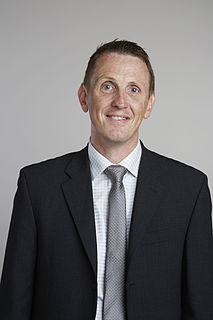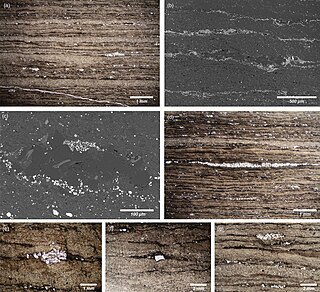Related Research Articles

Conodonts are extinct agnathan (jawless) vertebrates resembling eels, classified in the class Conodonta. For many years, they were known only from their tooth-like oral elements found in isolation and now called conodont elements. Knowledge about soft tissues remains limited. The animals are also called Conodontophora to avoid ambiguity.

Heinz Christian Pander, also Christian Heinrich Pander, was a Russian Empire ethnic Baltic German biologist and embryologist.
Pander may refer to:

Hindeodus is an extinct genus of conodonts in the family Anchignathodontidae. The generic name Hindeodus is a tribute to George Jennings Hinde, a British geologist and paleontologist from the 1800s and early 1900s. The suffix -odus typically describe's the animal's teeth, essentially making Hindeodus mean Hinde-teeth.

Philip Conrad James Donoghue FRS is a British palaeontologist and Professor of Palaeobiology at the University of Bristol.
Richard John Aldridge was a British palaeontologist and academic, who was Bennett Professor of Geology at the University of Leicester.
Professor Mark Andrew Purnell is a British palaeontologist, Professor of Palaeobiology at the University of Leicester.

The Soom Shale is a member of the Late Ordovician (Hirnantian) Cederberg Formation in South Africa, renowned for its remarkable preservation of soft-tissue in fossil material. Deposited in still waters, the unit lacks bioturbation, perhaps indicating anoxic conditions.
Euan N.K. Clarkson FRSE is a British palaeontologist and writer.

The Micropalaeontological Society (TMS) is a scientific society based in the UK with international membership. It was founded in 1970 for the promotion of the study of micropalaeontology, the study of microscopic fossils.
The Raymond C. Moore Medal for Paleontology is awarded by the Society for Sedimentary Geology to persons who have made significant contributions in the field which have promoted the science of stratigraphy by research in paleontology and evolution and the use of fossils for interpretations of paleoecology. The award is named after Professor Raymond C. Moore, the American paleontogist who helped to found the society.
Maurits Lindström was a Swedish geologist and paleontologist. Lindströms initial work was divided among two topics conodont paleontology and the structural geology of the Scandinavian Caledonides in Lappland.
George Jennings Hinde was a British geologist and paleontologist.
David L. Clark is a paleontologist. He was the W.H. Twenhofel Professor of Geology and Geophysics at the University of Wisconsin–Madison, Madison, Wisconsin.
Klaus Jürgen Müller was a German paleontologist.
Walter C. Sweet was an American paleontologist.
Stig M. Bergström is a Swedish-American paleontologist.
William Madison Furnish was an American paleontologist. He taught at the University of Iowa.
Raymond (Ray) Lindsay Ethington is an American paleontologist. He works in the Geology department at the University of Missouri in Columbia, Missouri
Gilbert Klapper is a paleontologist.
References
- ↑ Over, D. J.; Furnish, W. M. (1856). Conodont studies commemorating the 150th anniversary of the first conodont paper (Pander, 1856) and the 40th anniversary of the Pander Society. Ithaca, New York: Paleontological Research Institution. OCLC 494892038.
- ↑ Sweet, W. C., & Cooper, B. J. (2008). CH Pander's introduction to conodonts, 1856. EPISODES, 31(4), 429-432.
- ↑ Sweet, Walter C. (1988) The Conodonta: morphology, taxonomy, paleoecology, and evolutionary history of a long-extinct animal phylum. Oxford: Clarendon Press.
- ↑ Devonian Life and Evolution H.C. Pander and strange Conodonts